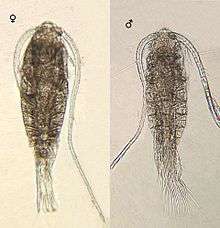Leptodiaptomus minutus
Leptodiaptomus minutus is a calanoid copepod native to the Laurentian Great Lakes and its basin.
| Leptodiaptomus minutus | |
|---|---|
 | |
| Female and male L. minutus | |
| Scientific classification | |
| Kingdom: | Animalia |
| Phylum: | Arthropoda |
| Subphylum: | Crustacea |
| Class: | Maxillopoda |
| Subclass: | Copepoda |
| Order: | Calanoida |
| Family: | Diaptomididae |
| Genus: | Leptodiaptomus Lilljeborg in Guerne & Richard, 1889 |
| Species: | minutus Lilljeborg in Guerne & Richard, 1889 |
Distribution
Leptodiaptomus minutus is found over most of North America north of the 40th parallel and in Greenland and Iceland. It may extend further south in mountainous areas of the East, but appears to be absent from the far western United States. It is found in all the Great Lakes and is particularly abundant in Lake Huron and Lake Michigan[1]
Identification
Leptodiaptomus minutus adult females are characterized by a two-segmented urosome, metasomal wings that are nearly symmetrical and rounded, and endopods of leg 5 are greatly reduced in size. In adult males, the small lateral spine on the terminal segment of leg 5 is located in the proximal third of the segment, and the right (geniculate) antennule has a slender process on the third to the last segment. This species is the smallest calanoid in the Great Lakes, only Leptodiaptomus ashlandi may overlap its size range. One might determine that the lateral spine on leg 5 of L. minutus is located more in the middle portion of the terminal segment. However, the size of the spine (less than half the width of the exopod terminal segment) would not allow its confusion with Onychodiaptomus sanguineus, Leptodiaptomus sicilis, or Leptodiaptomus siciloides, where the spine is at least as long as the width of the segment.[2] These species are physcially similar to other Leptodiaptomids (Leptodiaptomus ashlandi, Leptodiaptomus sicilis and Skistodiaptomids (Skistodiaptomus oregonensis).
References
- ↑ Mary D. Balcer, Nancy L. Korda & Stanley I. Dodson (1984). "Life history and ecology of the major crustacean species". Zooplankton of the Great Lakes: a guide to the identification and ecology of the common crustacean species. University of Wisconsin Press. pp. 49–109. ISBN 978-0-299-09820-9.
- ↑ Hudson, Patrick L., and Lynn T. Lesko. 2003. Free-living and Parasitic Copepods of the Laurentian Great Lakes: Keys and Details on Individual Species. Ann Arbor, MI: Great Lakes Science Center Home Page. http://www.glsc.usgs.gov/greatlakescopepods/MainMenu.php?